This is not a repetitive question though the title might seem similar.
Let's say I have a function f1() which plots an object of class "gTable,grob,gDesc" once. I'm using grid.draw() to plot the object.
So when we call :
pdf("filename.pdf", height = 10, weight =12)
f1()
dev.off()
This will give one page of pdf which is what i wanted.
However when i want two plots in a single pdf by the code :
pdf("filename.pdf")
f1()
f1()
dev.off()
I get is a single page pdf with just the second plot.That is the first plot was overwritten by the second. To overcome this I am using grid.newpage() but that adds one extra blank page in the pdf. How to avoid this? I can use an extra argument to create a newpage only if the argument is set. However do we have any other option?
I have played with grid.arrange() and also the onefile argument in pdf() but nothing worked.
Also when I try to plot these on the R plot window then it overwrites on the existing open graphical device. So after plotting second time, i am unable to view the first plot by using the back arrow. back arrow of R plot window
Edit : sample R code which plots an object of class "gTable, grob, gDesc"
xxx <- function(){
set.seed(1111)
dd <- diamonds[sample(1:nrow(diamonds), 1000, replace = TRUE), ]
dd$color <- sample(letters[1:2], 1000, replace = TRUE)
p <- ggplot(data = dd, aes(x = cut))
p1 <- p + geom_bar(fill = "orange", alpha = 1) + facet_wrap(~color)+
ggtitle("Main title")+scale_y_continuous("frequency", expand = c(0, 0))+
labs(x = "cut", y = "frequency")+
theme(panel.background = element_rect(colour = "white"),
axis.text.x = element_text(angle = 45, hjust = 1),
panel.grid.major = element_blank(),
panel.grid.minor = element_blank(),
legend.position = "bottom")
p2 <- p + geom_line(aes(y = price), alpha = 0)+
labs(x = "", y = "price")+expand_limits(y = 0) +
stat_summary(aes(y = price, group = 1, colour = "mean"), fun.y = "mean", geom = c("point"))+
stat_summary(aes(y = price, group = 1, colour = "mean"), fun.y = "mean", geom = c("line"))+
stat_summary(aes(y = price, group = 1, colour = "median"), fun.y = "median", geom = "point")+
stat_summary(aes(y = price, group = 1, colour = "median"), fun.y = "median", geom = "line")+
scale_colour_manual(name = "" ,breaks = c("mean", "median"), values = c("red", "blue"))+
facet_wrap(~color)+ylab("Exposures")+
theme(panel.background = element_rect(fill = NA, colour = "white"),
panel.grid.major = element_blank(),
panel.grid.minor = element_blank(),
panel.border = element_rect(fill = NA, colour = "grey50"),
legend.position = "bottom")
xx <- ggplot_build(p1)
yy <- ggplot_build(p2)
nrow <- length(unique(xx$panel$layout$ROW))
ncol <- length(unique(xx$panel$layout$COL))
npanel <- length(xx$panel$layout$PANEL)
g1 <- ggplot_gtable(xx)
g2 <- ggplot_gtable(yy)
pp <- c(subset(g1$layout, grepl("panel", g1$layout$name), se = t:r))
g <- gtable_add_grob(g1, g2$grobs[grepl("panel", g1$layout$name)],
pp$t, pp$l, pp$b, pp$l)
func1 <- function(grob){
widths <- grob$widths
grob$widths[1] <- widths[3]
grob$widths[3] <- widths[1]
grob$vp[[1]]$layout$widths[1] <- widths[3]
grob$vp[[1]]$layout$widths[3] <- widths[1]
grob$children[[1]]$hjust <- 1 - grob$children[[1]]$hjust
grob$children[[1]]$vjust <- 1 - grob$children[[1]]$vjust
grob$children[[1]]$x <- unit(1, "npc") - grob$children[[1]]$x
grob
}
index <- which(g2$layout$name == "ylab")
ylab <- g2$grobs[[index]] # Extract that grob
ylab <- func1(ylab)
ylab$children[[1]]$rot <- ylab$children[[1]]$rot + 180
g <- gtable_add_cols(g, g2$widths[g2$layout[index, ]$l], pos = max(pp$r))
g <-gtable_add_grob(g,ylab, t = min(pp$t), l = max(pp$r)+1,
b = max(pp$b), r = max(pp$r)+1,
clip = "off", name = "2ndylab")
j = 1
k = 0
for(i in 1:npanel){
if ((i %% ncol == 0) || (i == npanel)){
k = k + 1
# swap the 2nd y-axis label
index <- which(g2$layout$name == "axis_l-1") # Which grob
yaxis <- g2$grobs[[index]] # Extract the grob
ticks <- yaxis$children[[2]]
ticks$widths <- rev(ticks$widths)
ticks$grobs <- rev(ticks$grobs)
ticks$grobs[[1]]$x <- ticks$grobs[[1]]$x - unit(1, "npc")
ticks$grobs[[2]] <- func1(ticks$grobs[[2]])
yaxis$children[[2]] <- ticks
if ((k == 1) || ((i == npanel) & (i%%ncol != 0)))#to ensure just once d secondary axisis printed
g <- gtable_add_cols(g,g2$widths[g2$layout[index,]$l], max(pp$r[j:i]))
g <- gtable_add_grob(g,yaxis,max(pp$t[j:i]),max(pp$r[j:i])+1, max(pp$b[j:i])
, max(pp$r[j:i]) + 1, clip = "off", name = "2ndaxis")
j = i + 1
}
}
pp <- c(subset(g2$layout, name == "guide-box", se = t:r))
g <- gtable_add_grob(g, g2$grobs[[which(g2$layout$name == "guide-box")]], t = pp$t,
l = pp$r, b = pp$b, r = pp$r )
grid.draw(g)
}
This is a sample function. So if I call the following code:
pdf("zzz.pdf")
xxx()
xxx()
dev.off()
Only a single page pdf is created in above case. And if you simply call
xxx()
xxx()
Then in the R plot window Ican just view the second plot. The back arrow button is disabled since the first plot was overwritten.

